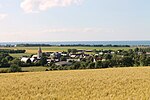Ferme de la Rançonnière
The Ferme de la Rançonniere is a farm located in the commune of Crépon, Calvados department, Normandy, France. The first buildings were constructed in the 13th century, when the residence was called La Ferme de Biéville. At that time, Normandy was suffering from the tensions between the English crown and the kingdom of France, which eventually evolved into the Hundred Years War. Since at least 1463 the fiefdom of Biéville, to which the farm belonged, was in the hands of the Chastel family, whose coat of arms can be found on the fresco painted on the round tower. Most of the farm was reconstructed in the first part of the 17th century; the tower, which had lost its spiral stairway, is the only remnant of the original farm. In 1710, the farm was acquired by the de la Rançonnière family, to which it owes its current name.
Excerpt from the Wikipedia article Ferme de la Rançonnière (License: CC BY-SA 3.0, Authors).Ferme de la Rançonnière
Route de Creully, Bayeux
Geographical coordinates (GPS) Address Phone number Website Nearby Places Show on map
Geographical coordinates (GPS)
| Latitude | Longitude |
|---|---|
| N 49.311944444444 ° | E -0.54722222222222 ° |
Address
Ferme de La Rançonnière
Route de Creully 9
14480 Bayeux
Normandy, France
Open on Google Maps









